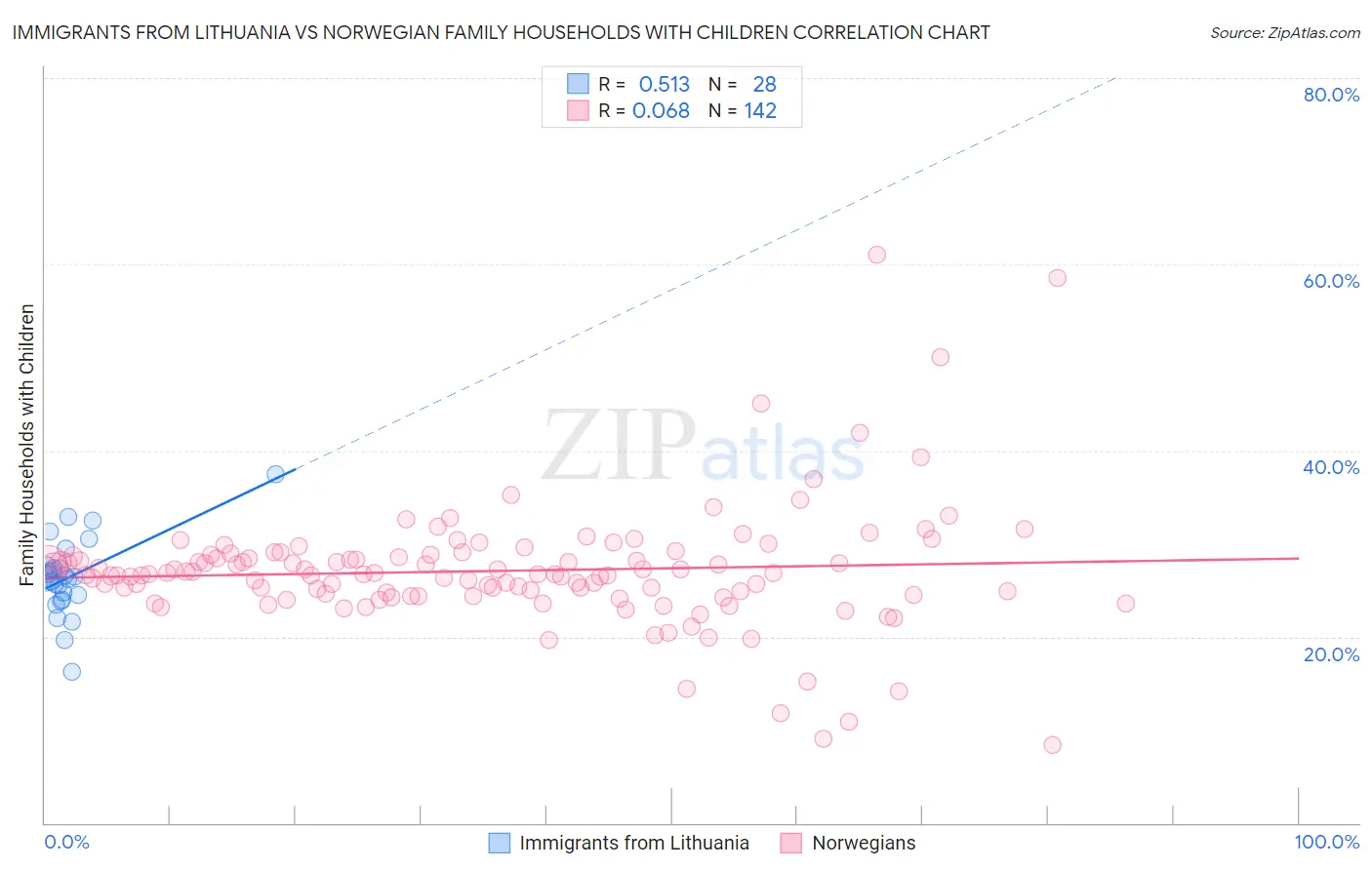Immigrants from Lithuania vs Norwegian Family Households with Children
COMPARE
Immigrants from Lithuania
Norwegian
Family Households with Children
Family Households with Children Comparison
Immigrants from Lithuania
Norwegians
26.8%
FAMILY HOUSEHOLDS WITH CHILDREN
1.2/ 100
METRIC RATING
259th/ 347
METRIC RANK
27.4%
FAMILY HOUSEHOLDS WITH CHILDREN
35.0/ 100
METRIC RATING
197th/ 347
METRIC RANK
Immigrants from Lithuania vs Norwegian Family Households with Children Correlation Chart
The statistical analysis conducted on geographies consisting of 117,683,202 people shows a substantial positive correlation between the proportion of Immigrants from Lithuania and percentage of family households with children in the United States with a correlation coefficient (R) of 0.513 and weighted average of 26.8%. Similarly, the statistical analysis conducted on geographies consisting of 532,567,428 people shows a slight positive correlation between the proportion of Norwegians and percentage of family households with children in the United States with a correlation coefficient (R) of 0.068 and weighted average of 27.4%, a difference of 2.1%.

Family Households with Children Correlation Summary
| Measurement | Immigrants from Lithuania | Norwegian |
| Minimum | 16.2% | 8.3% |
| Maximum | 37.4% | 61.1% |
| Range | 21.2% | 52.7% |
| Mean | 26.4% | 27.1% |
| Median | 26.4% | 26.7% |
| Interquartile 25% (IQ1) | 24.3% | 24.5% |
| Interquartile 75% (IQ3) | 27.5% | 28.8% |
| Interquartile Range (IQR) | 3.3% | 4.2% |
| Standard Deviation (Sample) | 4.2% | 6.7% |
| Standard Deviation (Population) | 4.1% | 6.7% |
Similar Demographics by Family Households with Children
Demographics Similar to Immigrants from Lithuania by Family Households with Children
In terms of family households with children, the demographic groups most similar to Immigrants from Lithuania are Immigrants from Jamaica (26.8%, a difference of 0.020%), Immigrants from Cuba (26.8%, a difference of 0.030%), Slavic (26.8%, a difference of 0.040%), Immigrants from Belarus (26.8%, a difference of 0.070%), and Scotch-Irish (26.8%, a difference of 0.080%).
| Demographics | Rating | Rank | Family Households with Children |
| Irish | 1.8 /100 | #252 | Tragic 26.8% |
| Italians | 1.5 /100 | #253 | Tragic 26.8% |
| Immigrants | Scotland | 1.5 /100 | #254 | Tragic 26.8% |
| German Russians | 1.5 /100 | #255 | Tragic 26.8% |
| Scotch-Irish | 1.4 /100 | #256 | Tragic 26.8% |
| Slavs | 1.3 /100 | #257 | Tragic 26.8% |
| Immigrants | Cuba | 1.3 /100 | #258 | Tragic 26.8% |
| Immigrants | Lithuania | 1.2 /100 | #259 | Tragic 26.8% |
| Immigrants | Jamaica | 1.2 /100 | #260 | Tragic 26.8% |
| Immigrants | Belarus | 1.1 /100 | #261 | Tragic 26.8% |
| Immigrants | Russia | 1.0 /100 | #262 | Tragic 26.8% |
| Immigrants | North Macedonia | 1.0 /100 | #263 | Tragic 26.7% |
| Taiwanese | 0.9 /100 | #264 | Tragic 26.7% |
| Chippewa | 0.9 /100 | #265 | Tragic 26.7% |
| Maltese | 0.9 /100 | #266 | Tragic 26.7% |
Demographics Similar to Norwegians by Family Households with Children
In terms of family households with children, the demographic groups most similar to Norwegians are Cheyenne (27.4%, a difference of 0.0%), Immigrants from Romania (27.4%, a difference of 0.010%), Crow (27.4%, a difference of 0.020%), Immigrants from Iran (27.4%, a difference of 0.030%), and Swedish (27.4%, a difference of 0.050%).
| Demographics | Rating | Rank | Family Households with Children |
| Immigrants | Uruguay | 37.7 /100 | #190 | Fair 27.4% |
| Sudanese | 37.6 /100 | #191 | Fair 27.4% |
| Pennsylvania Germans | 37.5 /100 | #192 | Fair 27.4% |
| Swedes | 36.9 /100 | #193 | Fair 27.4% |
| Immigrants | Iran | 36.1 /100 | #194 | Fair 27.4% |
| Crow | 35.7 /100 | #195 | Fair 27.4% |
| Cheyenne | 35.1 /100 | #196 | Fair 27.4% |
| Norwegians | 35.0 /100 | #197 | Fair 27.4% |
| Immigrants | Romania | 34.4 /100 | #198 | Fair 27.4% |
| English | 32.0 /100 | #199 | Fair 27.3% |
| Immigrants | Congo | 28.7 /100 | #200 | Fair 27.3% |
| Bhutanese | 25.1 /100 | #201 | Fair 27.3% |
| Americans | 22.8 /100 | #202 | Fair 27.3% |
| Kiowa | 22.2 /100 | #203 | Fair 27.3% |
| Immigrants | Sudan | 21.6 /100 | #204 | Fair 27.3% |